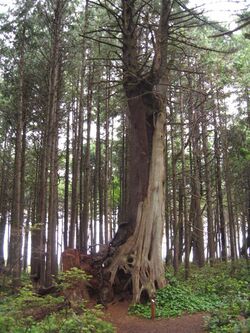Earth:Nurse tree


A nurse tree is a larger, faster-growing tree that shelters a smaller, slower-growing tree or plant. The nurse tree can provide shade, shelter from wind, and protection from animals that would feed on the smaller plant and significant changes in temperature.[1] Fallen leaves from the nurse tree fertilize the ground underneath creating nutrient-rich soil for the saplings and vegetation beneath.[2] Some nurse trees act as Nitrogen-fixing agents in the soil.[1] The nurse tree relationship occurs both naturally and via human intervention.
Examples
The Norway spruce (Picea abies) and larch (Larix) can function as nurses for hardwoods.[3]
In the Sonoran Desert, Palo Verde, ironwood and mesquite trees serve as nurse trees for young saguaro cacti. As the Saguaro grows and becomes more acclimated to the desert sun, the older tree may die, leaving the saguaro alone. As the Saguaro grows larger, it may compete with its nurse tree for resources, hastening its death. Consequently, young saguaros are often seen adjacent to trees, while old saguaros are not.[4]
References
- ↑ 1.0 1.1 Högberg, Peter; Högberg, Mona N. (July 2022). "Does successful forest regeneration require the nursing of seedlings by nurse trees through mycorrhizal interconnections?" (in en). Forest Ecology and Management 516: 120252. doi:10.1016/j.foreco.2022.120252. https://linkinghub.elsevier.com/retrieve/pii/S0378112722002468.
- ↑ Ayana Elizabeth Johnson, ed (2021). All we can save: truth, courage, and solutions for the climate crisis. New York: One World. ISBN 978-0-593-23708-3. OCLC 1245346058.
- ↑ Northern Ireland, Planning Service Website. A Design Guide for Rural Northern Ireland. Appendix 3: Tree Species.
- ↑ National Park Service. How Saguaros Grow.
- John Vandermeer. Saguaros and Nurse Trees: A New Hypothesis to Account for Population Fluctuations. The Southwestern Naturalist, Vol. 25, No. 3 (Nov. 14, 1980), pp. 357–360. doi:10.2307/3670691
 |
